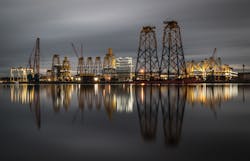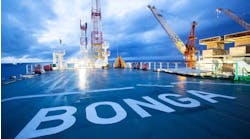Jackets at OGN yard in Wallsend, UK for Beatrice wind farm in the North Sea. (Photo courtesy Eiffage Métal)
Offshore construction activity is slowly reviving, with more new and brownfield projects finally going forward. One fabrication specialist hoping to benefit is Eiffage Métal, which plans to tender for various new programs in the Atlantic basins.
Total Austral is looking to install a wellhead platform on the Fenix gas accumulation offshore Tierra del Fuego, southern Argentina. Assuming the project is sanctioned Eiffage Métal would propose building the facilities in Europe, mostly at the company’s yard in Fos-sur-Mer in southern France, with some structural work subcontracted to yards in other countries.
In partnership with Saipem, the company has been awarded the project for construction of the shallow-water hub LNG terminal breakwater jetty for BP/Kosmos’ Tortue gas-condensate development offshore Senegal and Mauritania. The partners also plan to bid for the topsides and a living quarter with the hub utilities platform that will be installed alongside the jetty. The topsides will allow the transfer of gas between the floating LNG vessel and the LNG carriers. If the bid is successful, Saipem would fabricate these and Eiffage Métal the living quarters. According to the latter’s Industrial Division Director Arnaud de Villepin, local works would be undertaken by the company’s Senegalese subsidiary Eiffage Senegal, with the remainder handled by a low-cost yard, probably in Asia.
“What is important to note,” de Villepin stressed, “is that we recently acquired Saipem Travaux Maritimes, a specialist in port construction, and their team is now integrated into our headquarters at Velizy-Villacoublay near Paris under the name Eiffage Marine. They are currently working on a major project to build a jetty in Kuwait.”
Previously, Eiffage Métal built living quarter platforms for Total’s Amenam and Ofon projects offshore Nigeria via consortia with indigenous engineering and construction groups, and the company hopes to bid for work on three potential new Nigerian developments. Total’s Ikeke development (a wellhead platform) is in shallow water while Eni’s ZabaZaba/Etan and SNEPCO’s Bonga SW project are both deepwater. In these cases, the target is living quarters for the FPSOs, fabricated in Nigeria as local content.
Elsewhere, the company has a design contract, with an option for construction, of a proposed floating wind farm offshore Perpignan on France’s southwest Mediterranean coast, close to the border with Spain, under a co-operation with power group ENGIE. The complex, based on a concept developed by Principal Power, would comprise four floaters, each with a weight of 1,800 metric tons (1,984 tons). If the contract option is exercised, Fos, which is strategically located near Marseille, would fabricate the structures during 2020-21. “If the market for floating wind farms grows – Spain and Portugal are also looking at this concept – we would probably increase the capacity at Fos,” de Villepin said.
At present the yard is producing large volumes of modular bridges for a civil engineering project is The Philippines, however the bridges are also suited to swamp area or coastal infrastructure related to oil and gas field developments in tropical regions. One of Fos’ recent consignments was for ExxonMobil for a near-shore field development in Papua New Guinea. Fos has also been fabricating transition pieces between the masts and jackets of a series of offshore wind turbines under construction at OGN’s yard at Wallsend on the River Tyne, northeast England.
Eiffage Métal has taken a mid-term lease on part of the site to build jackets for the Aberdeen Bay and Beatrice wind farms in the UK North Sea (Seaway Heavy Lifting is the client and installation contractor in Beatrice’s case). Eiffage Métal is working with Scottish fabricator BiFab on this program, building around 50 jackets, each with a weight of 1,200 metric tons (1,330 tons) and a height of 60 m (196 ft).
“We are looking at some form of standardized process for the jackets,” de Villepin said. “In some aspects construction is different compared to oil and gas platform jackets because the arrangement is not the same – the connections to take care of are to the turbines and electrical cables. However, windfarm jackets sizes are determined by the dynamic loads of the turbines and the fatigue, whereas an oil and gas jacket dimensions are often calculated on the basis of static loads. Windfarm jackets are fixed to the seafloor by pin piles and levelling of the jackets is necessary on the seabed in order to limit the inclination of the turbines. When the right position is obtained, the connecting points are filled with grout.”
Another confirmed offshore wind farm project – France’s first – is 15 km (9.3 mi) from the port of St Nazaire, near Nantes. Here Eiffage Métal is in an EPCI consortium with Belgium’s DEME Group: construction will start early next year and continue for 18 months at Fos, at the company’s plants in Poland, and at Smulders (another subsidiary) in Antwerp. The completed facilities will be transported initially to La Rochelle, south of St Nazaire, and installed by DEME during 2020-21.




